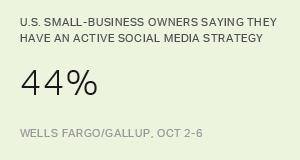PRINCETON, NJ -- At least seven in 10 U.S. small-business owners say a better sales outlook, more certainty about their operating environment, and lower federal taxes would make their companies more likely to make capital investments in the next 12 months. Lower on the list -- although still chosen by a majority -- were fewer government regulations, more affordable technology, and special government tax credits.
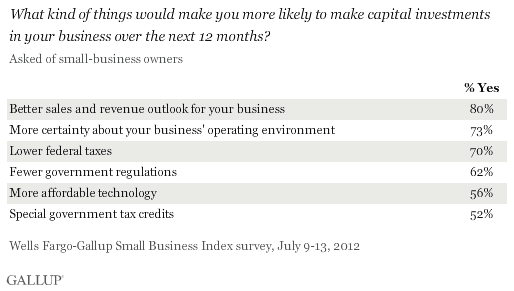
These results are from the quarterly Wells Fargo-Gallup Small Business Index survey, conducted July 9-13, 2012, with a random sample of 600 small-business owners.
Overall, 41% of U.S. small-business owners expect to make capital investments over the next 12 months. That compares with 53% who say they have made capital investments over the past 12 months.
State of the Economy Top Issue for Those Not Intending to Make Capital Investments
In a separate question, the 57% of small-business owners who said they do not plan to make capital investments over the next year were asked to say whether each of six issues was a reason for this.
The top response, at 63%, was that they are too concerned about the overall state of the economy to do so. This was followed by feeling too uncertain about the future of their business (56%), feeling that their business doesn't need capital improvements (54%), and a lack of revenue and profits to make new capital investments (53%). About one in three owners said the needed capital improvements are too expensive or that they are too uncertain about the availability of credit to make such improvements.
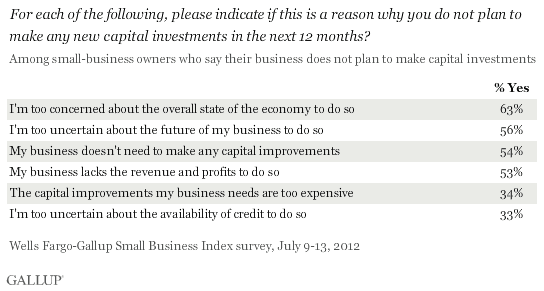
Owners Planning Capital Investments Focus on New Equipment and Technology
The 41% of owners who intend to make capital investments over the next 12 months are most likely to say they plan to invest in new equipment and machinery (64%) and new computers (61%). More than half of these owners plan to invest in new software or a new website (56%) or new mobile devices (52%). Forty-one percent say they plan to invest in business expansion or development of new products, while 16% are looking toward investing in new facilities.
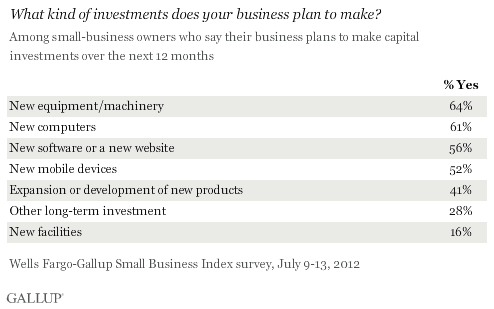
Owners Plan to Use Internally Generated Funds for Capital Investments
Nine in 10 small-business owners who intend to make capital investments over the next 12 months plan to fund their investments using their company's profits. Additional funding sources include credit, mentioned by 39%, savings (31%), and outside investors (14%).
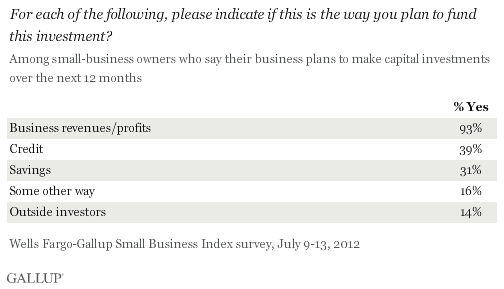
In a separate question and reflecting owners' intentions to largely self-fund their future capital investments, only 14% expect to apply for any form of new credit for their business over the next year.
Implications
The factors inhibiting small-business owners as they consider making capital investments over the next 12 months are consistent with the overall decline in owner optimism since April. They also seem consistent with the slowing of the overall U.S. economy as well as declining economic confidence and a worsening unemployment situation.
At the same time, two reasons small-business owners most commonly say would make them more likely to make capital investments -- better sales and a more certain operating environment -- suggest this situation is unlikely to change in the near future. Given the high unemployment rate and increasing gas prices, it seems unlikely small-business owners will see an improved sales outlook anytime soon.
Further, the run-up to the presidential election may increase economic uncertainty, rather than reducing it. The pending election has also brought things nearly to a halt in Washington, suggesting the federal government is not likely to make much effort in the near term to help small businesses by lowering federal taxes, reducing federal regulations, and/or providing special government tax credits. Thus, small business may be in a holding pattern of sorts until the outcome of the Nov. 6 election is known.
About the Wells-Fargo Small Business Index
Since August 2003, the Wells Fargo-Gallup Small Business Index has surveyed small-business owners on current and future perceptions of their business financial situations.
Survey Methods
Results for the total dataset are based on telephone interviews with 600 small-business owners, conducted July 9-13, 2012. For results based on the total sample of small-business owners, one can say with 95% confidence that the maximum margin of sampling error is ±4 percentage points.
Sampling is done on a random-digit-dial basis using Dun & Bradstreet sampling of small businesses having $20 million or less of sales or revenues. The data are weighted to be representative of U.S. small businesses within this size range nationwide.
Interviews are conducted with respondents on landline telephones and cellular phones, with interviews conducted in Spanish for respondents who are primarily Spanish-speaking. Each sample includes a minimum quota of 400 cell phone respondents and 600 landline respondents per 1,000 national adults, with additional minimum quotas among landline respondents by region. Landline telephone numbers are chosen at random among listed telephone numbers. Cell phone numbers are selected using random-digit-dial methods. Landline respondents are chosen at random within each household on the basis of which member had the most recent birthday.
Samples are weighted by gender, age, race, Hispanic ethnicity, education, region, adults in the household, and phone status (cell phone only/landline only/both, cell phone mostly, and having an unlisted landline number). Demographic weighting targets are based on the March 2011 Current Population Survey figures for the aged 18 and older non-institutionalized population living in U.S. telephone households. All reported margins of sampling error include the computed design effects for weighting and sample design.
In addition to sampling error, question wording and practical difficulties in conducting surveys can introduce error or bias into the findings of public opinion polls.
For more details on Gallup's polling methodology, visit www.gallup.com.
